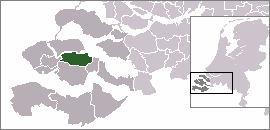Please tell us which country and city you'd like to see the weather in.
| Goes | |||
|---|---|---|---|
| — Municipality / City — | |||
|
|||
| Coordinates: 51°30′N 3°53′E / 51.5°N 3.883°E | |||
| Country | Netherlands | ||
| Province | Zeeland | ||
| Area(2006) | |||
| • Total | 102.09 km2 (39.42 sq mi) | ||
| • Land | 92.84 km2 (35.85 sq mi) | ||
| • Water | 9.24 km2 (3.57 sq mi) | ||
| Population (1 January 2007) | |||
| • Total | 36,623 | ||
| • Density | 394/km2 (1,020/sq mi) | ||
| Source: CBS, Statline. | |||
| Time zone | CET (UTC+1) | ||
| • Summer (DST) | CEST (UTC+2) | ||
| Area code(s) | 0113 | ||
Goes (![]() pronunciation (help·info)) is a municipality and a city in the southwestern Netherlands in Zuid-Beveland, in the province Zeeland. The city of Goes has approximately 27,000 residents.
pronunciation (help·info)) is a municipality and a city in the southwestern Netherlands in Zuid-Beveland, in the province Zeeland. The city of Goes has approximately 27,000 residents.
Contents |
History [link]
Goes was founded in the 10th century on the edge of a river: de Korte Gos (the Short Gos). The village grew fast and in the early 12th century it had a market square and a church devoted to Maria. In 1405 Goes received city rights, and in 1417 it was allowed to build walls around the city. The prosperity of the city was based upon the cloth industry and the production of salt. In the 16th century Goes declined. Its connection to the sea got bogged down and in 1544 a large fire destroyed a part of the city.
In 1577 the Spanish soldiers who occupied Goes were driven out by Prince Maurits of Nassau. The prince built a defence wall around Goes, which is still partly present. In the centuries thereafter Goes did not play an important role, except as an agricultural centre. In 1868 a railway was constructed through it, but this did not lead to industrialisation. Agriculture remains the most important economic activity.
Although The Netherlands were neutral in the First World War, seven bombs hit Goes and Kloetinge, due to an error by a British airplane. A house in Magdalenastreet in Goes was destroyed and one person killed. Goes did not suffer extensive damage during the Second World War, but was under German occupation until 1944.
Goes did not experience much population growth until the 1970s and 1980s. Then, the city grew fast because of new districts like Goese Meer, Oostmolenpark, Overzuid and Ouverture being constructed. Goes is now the fourth economic centre in Zeeland.
New districts are in preparation, amongst them Goese Schans, Mannee and Aria, where 3,000 new houses are to be built.
Population centers [link]
- Eindewege
- Goes
- 's-Heer Arendskerke
- 's-Heer Hendrikskinderen
- Kattendijke
- Kloetinge
- Oud-Sabbinge
- Wilhelminadorp
- Wolphaartsdijk
Districts [link]
- Centre Goes
- West Goes
- New West
- East Goes
- Noordhoek
- Goese Meer
- Goese Polder
- South Goes
- Overzuid
- Ouverture
- De Goese Poort (business area)
- De Poel (I, II, III en IV, business area)
- Klein Frankrijk (business area)
- Marconi (business area)
- Aria (developing)
- Mannee (developing)
- Goese Schans (developing)
International relations [link]
Twin towns — sister cities [link]
Goes is twinned with:
Transportation [link]
Railway Station: Goes
On the railway line between Vlissingen and Roosendaal.
See also [link]
External links [link]
| Wikimedia Commons has media related to: Goes |
|
|||||||||||
Coordinates: 51°30′N 3°53′E / 51.5°N 3.883°E
| This article about a location in Zeeland is a stub. You can help Wikipedia by expanding it. |
https://wn.com/Goes

Goes (genus)
Goes is a genus of longhorn beetles, containing the following species:
References

GOES 11
GOES 11, known as GOES-L before becoming operational, is an American weather satellite, which is part of the US National Oceanic and Atmospheric Administration's Geostationary Operational Environmental Satellite system. It was launched in 2000, and operated at the GOES-WEST position, providing coverage of the west coast of the United States, until December 6, 2011.
Launch
GOES-L was launched aboard an International Launch Services Atlas IIA rocket, flying from Space Launch Complex 36A at the Cape Canaveral Air Force Station. The launch occurred at 07:07 GMT on 3 May. The launch was originally scheduled for 15 March 1999, however it was delayed to allow the Eutelsat W3 satellite to be launched first. Following this, it was rescheduled for 15 May. On 30 April, the Centaur upper stage of a Titan IV(401)B failed during the launch of USA-143. Since a version of the Centaur was also used on the Atlas II, the launch of GOES-L was delayed a week to ensure that the same problem would not affect its launch. Less than five days after the Titan failure, a Delta III failed to launch Orion 3. The failure occurred during the second stage restart, and as the Delta III and Atlas II both used RL10 engines on their second stages, this resulted in a further delay.








